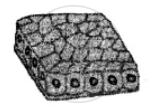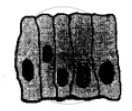Advertisements
Advertisements
प्रश्न
Answer the following question.
Describe different types of cell junctions.
उत्तर
The different types of cell junctions are as follows:
- Gap Junctions (GJs):
These are intercellular connections that allow the passage of ions and small molecules between cells as well as the exchange of chemical messages between cells. - Adherens Junctions (AJs):
They are involved in various signalling pathways and transcriptional regulations. - Desmosomes (Ds):
They provide mechanical strength to epithelial tissue, cardiac muscles and meninges. - Hemidesmosomes (HDs):
They allow the cells to strongly adhere to the underlying basement membrane. These junctions help maintain tissue homeostasis by signalling. - Tight junctions (TJs):
These junctions maintain cell polarity, prevent lateral diffusion of proteins and ions.
APPEARS IN
संबंधित प्रश्न
Distinguish between Simple epithelium and compound epithelium
Based on the following information, identify the three types of epithelial tissue in the figures given below :
| a |  |
b |  |
c |  |
(1) Cuboidal epithelium: It consists of a single layer of cuboidal cells.
(2) Columnar epithelium: It is composed of tall, cylindrical cells with oval nuclei usually placed at the base of the cells.
(3) Ciliated epithelium: It consists of cells being hair-like cilia on their free surface.
How many types of epithelial tissues have you studied? Write their functions.
The ciliated epithelium lines the______.
Write true (T) or false (F)
Epithelial cells have a lot of intercellular spaces.
Give reasons for
Meristematic cells have a prominent nucleus and dense cytoplasm but they lack vacuole.
The ______ epithelium is also known as the pavement membrane.
An epithelial layer does not allow the regulation of materials between the body and the external environment.
Mention the type of epithelium seen in the alveoli of lungs.
How does a gap junction facilitate intercellular communication?
